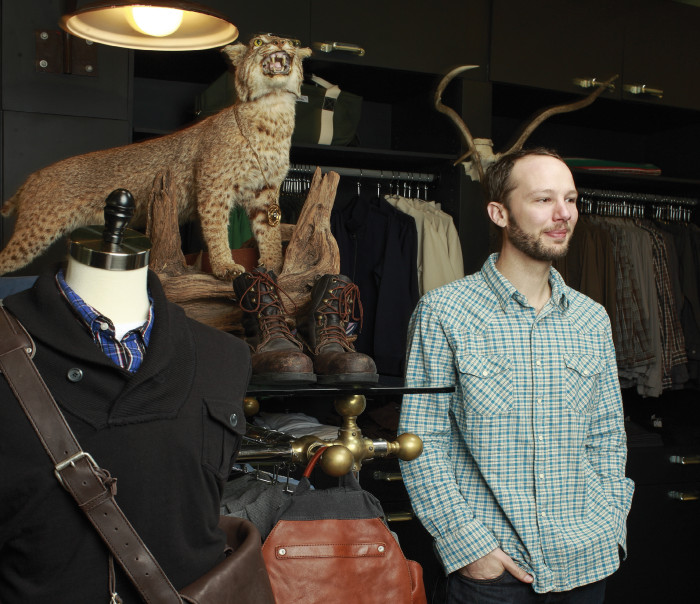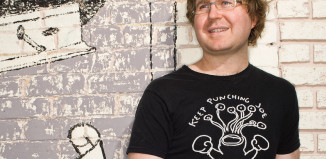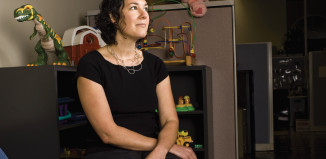Ted Allen is all about embracing vices. He explains that he’d quit smoking for several years but took up the habit in the busy months leading up to the opening of Stag, the new menswear shop he co-owns on South Congress Avenue in Austin.
“I thought, ‘you know what? I’m not going to apologize for my vice,” Allen said.
Chatting over coffee on a surprisingly balmy January afternoon, Allen is forthcoming, earnest and funny, discussing many aspects of his life: the aesthetic of Stag, which is unique among men’s clothing stores in Austin; the strength of his relationship with his partner of more than eight years, interior designer Joel Mozersky; and his broader ideas about menswear here in the capital city.
Allen described himself as driven by classic looks and said his own closet consists of probably 30-percent vintage and 70-percent new clothing, with a smattering of a few choice luxury items.
“I think that’s kind of about how most of Austin dresses,” he said.
He admitted to making a fashion faux pas or two in his early 20s, and at times looking more silly than manly, with a nod to the idea that everyone has questioned the sartorial choices of their youth.
Prior to coming to Austin, Allen worked as a stock room manager and assistant manager at retail giant GAP in Oklahoma City, and he credits the company with giving him a foundation in certain standard industry practices (shirts should be stacked and sized this way, not that way, for ex- ample) that are now hard-wired in to his brain.
“I can perfect fold with my eyes closed,” he joked. “Even as a kid, when I was at GAP, I was perplexed as to why every year they’d put out the same red sweater with the horizontal stripes.”
It’s that curiosity that ultimately led Allen, along with four business partners, to open Stag.
About two years ago, Allen and his partners (Mozersky, Mercury Design owner Steve Shuck and his partner Bobby Johns, and open road antiques’ Don Weir) started putting a business plan together when they realized they all shared similar goals for the look and feel a men’s shop should offer Austinites. The initial meetings were brainstorming sessions over dinner, sorting through magazines and ephemera and considering about what’s great about menswear.
“We made a really big look book,” Allen said. “The great thing about having five partners is that you can delegate and take advantage of everyone’s strengths.”
And it’s certainly a tremendous depth of experience from which to draw: Shuck was operations Director of GAP, where he spearheaded the company’s launch in to Europe and assisted with the creation of Old Navy; Johns worked in operations for Whole Foods Market; and all of the men enjoy antiquing and have long been involved in retail in one way or another.
“Welcome to our man emporium,” said a beaming Mozersky on a recent visit.
 Stag’s tag line is “authentic red-blooded style,” and the store delivers a very unique kind of shopping experience. With its unfinished concrete floor, comfy leather couches and hunting paraphernalia (a bear head hangs on one wall and a stuffed white coyote is perched above one of the garmet racks), and classic, rugged vibe, the space is inviting and decidedly masculine, but definitely not pretentious. In this era of retail-stores-as-art-galleries, where clothes are often presented in environments that are sterile and devoid of sexual energy, Stag is putting the man back in manly. It’s also the kind of store where a 20-year-old University of Texas student would be comfortable shopping alongside a 40-something father of two, who might be standing next to a 30-something woman buying her boyfriend a pair of jeans, while the Rolling Stones or Bob Dylan croon in the background on the speakers.
Stag’s tag line is “authentic red-blooded style,” and the store delivers a very unique kind of shopping experience. With its unfinished concrete floor, comfy leather couches and hunting paraphernalia (a bear head hangs on one wall and a stuffed white coyote is perched above one of the garmet racks), and classic, rugged vibe, the space is inviting and decidedly masculine, but definitely not pretentious. In this era of retail-stores-as-art-galleries, where clothes are often presented in environments that are sterile and devoid of sexual energy, Stag is putting the man back in manly. It’s also the kind of store where a 20-year-old University of Texas student would be comfortable shopping alongside a 40-something father of two, who might be standing next to a 30-something woman buying her boyfriend a pair of jeans, while the Rolling Stones or Bob Dylan croon in the background on the speakers.
In the run-up to the store’s launch in early December, Allen thoroughly researched how and why men shop for clothes. Delving in to the generational shift that’s taken place in recent years as the average man younger than 40 has gone from seldom shopping to being much more comfortable with it.
“The vast majority of men are solution-based shoppers,” he said, explaining that often men will buy, say, a new pair of leather shoes when the old pair is scratched up or has a gaping hole in it.
Far from snobbishly dictating how men should dress, Allen and his partners have created a space where a guy can feel fine just being a guy, whether he ultimately buys some- thing or not.
“Men are more comfortable being in stores and trying on garments,” Allen said. “I wanted to think about why my grandfather might feel comfortable shopping now.”
After considering hundreds of name ideas, Allen and his partners settled on one of Shuck’s suggestions that they all loved: Stag, for its connotation of masculinity in terms of the actual animal and as in “going stag” to a party. The store’s offerings include, on the higher end, Double RL, Ralph Lauren’s vintage-style line; Life/After/Denim, a Los Angeles-based line focused on quality, and functional and wearable menswear; organic v-neck shirts from alternative earth; Franklin + Gower, makers of custom-made pants and shirts with a range of funky prints and details; and quirky t- shirts from alternative apparel. Beyond these labels, Stag sells some vintage clothes, a range of Taschen books including the “Big Book of Breasts,” knives, flasks and vintage cocktail shaker sets, Jack Black skin care products, old lamps, cool posters, some jewelry, handmade HELM boots and leather wallets.
Allen moved to Austin 10 years ago from Oklahoma City, a place he describes as stifling for a young gay man, but also a great city for two of his favorite pastimes: junking and antiquing. Although his childhood sounds carefree enough (his hobbies included making forts, playing in creeks and shooting BB guns) he was destined to live in a more tolerant, cosmopolitan city. He had friends who’d already moved to Austin and they’d taken a few road trips to see bands. With its reputation as the liberal mecca of the South, moving here was a no-brainer.
“I literally packed everything into my Ford Focus and drove down,” He said, noting that his first job in Austin was at Chuy’s.
It turns out that Mozersky’s brother used to eat at Chuy’s all the time. On Tuesday nights, they would all sing karaoke at Club De Ville.
“The first time I saw [Joel] he was about to sing Andy Gibb’s ‘I Just Want to Be Your Everything,’” Allen said. Mutual friends were matchmakers and Allen had asked around about Mozersky. Allen said working with the man he loves has been drama-free. He credits the success of their relationship to the basics: love and communication.
“I think that just about every issue or problem, if you’re being honest the entire time, there’s not much that can really sneak up on you,” he said.
After toiling at Chuy’s for almost two years and regularly hitting up estate sales, antique stores and feeding his love of junking, Allen interviewed for and got a job at Uncommon Objects, where he worked for four years in management and sales. Later, Shuck recruited him to Mercury Design, where he assisted with choosing some of the store’s vintage items.
Allen described a stint working in the women’s shoe department at Neiman Marcus as a “great learning experience,” but the commission sales environment wasn’t his cup of tea.
“I was good at it, but it doesn’t really fit in to my skill- set,” Allen said. “I can be a hawk and push people in to buying things, but I prefer to be more customer-service oriented.”
When he’s not running operations at Stag, you’ll likely find Allen at home with his partner, planting in his garden or taking care of his three dogs.
“Shopping, for me, is something I enjoy doing by myself. I love being able to dig through piles of things without feeling like I need to hurry up for someone else,” he said, adding that he prefers antique and vintage shops that smell like, well, antique and vintage shops, where he can spend a chunk of time sorting through piles of junk. “I like shopping at my own pace, and Joel’s the same. Most times we take separate cars when we shop; he likes to leave way before I’m ready.”
Where does he go for inspiration?
“Most of my inspiration is driven from my antique store shopping,” he said, noting that Oklahoma City, where he returns once a year, is one of his favorite places to go junking because it’s an aesthetic of what is old is new.
“It’s a little bit scary when I shop there now,” he admitted, smiling. “I get a lot of, ‘you’re not from around here, are you?’ or, ‘you be careful around here.’”




































